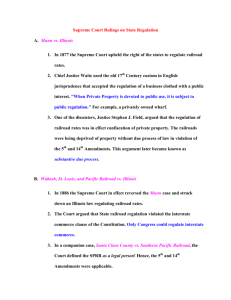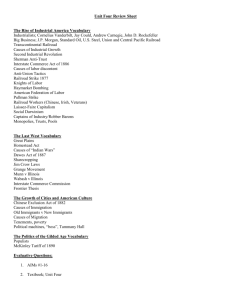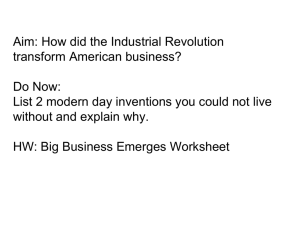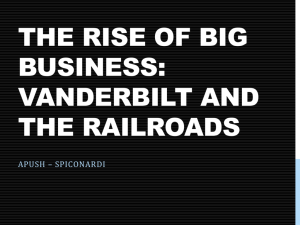Munn v. Illinois - White Plains Public Schools
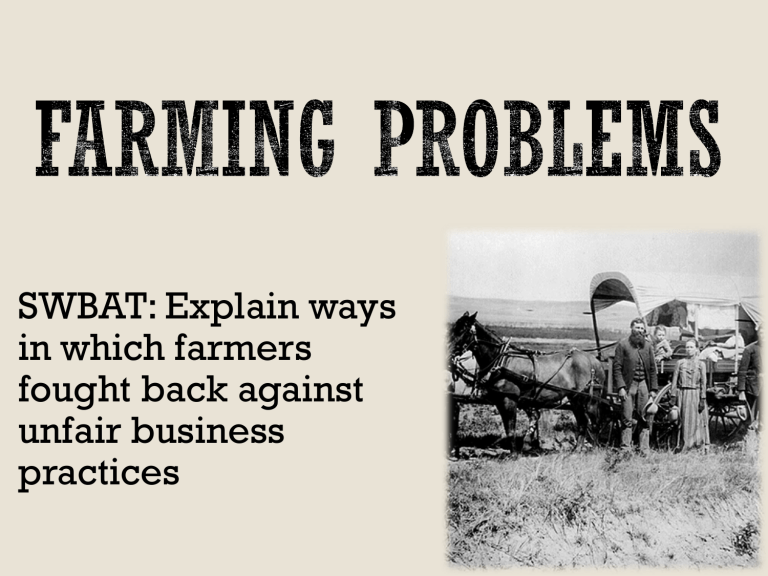
SWBAT: Explain ways in which farmers fought back against unfair business practices
Explain the message in this lithograph:
Overdevelopment & over farming of the West
Conservationist Movement
Yellowstone National Park
1872: Congress set 2 million acres aside for the world’s first national park
The Northern Pacific Railroad company lobbied Congress for a national park to support railroad tourism
U.S. Fisheries Commission
Made recommendations to address the declining commercial fish population
Late 1800s- improvements in mechanization & specialization of farming
Larger farms ran like factories small farms could not compete driven out of business
Falling Prices
1867: wheat $2.00/bushel 1889:
$.70/bushel
1867: corn $.78/bushel 1889: $.28/bushel
Effects:
Farms with mortgages faced high interest rates, could not pay off old debts
Foreclosures by banks
More tenants & sharecroppers
Rebates- special discounts given to railroad company’s best customers
If a shipper promised to exclusively use a railroad company special low freight rate
Allowed a shipper to undercut competitors
Smaller railroad & shipping companies would go out of business
Pools- railroad companies in the same market would agree to divide up business to avoid competition
This led to price fixing- railroad companies conspired to charge same high shipping rates to customers
Industries kept prices high with monopolies
Wholesalers got their “cut”
Railroads & warehouses took profits by charging high rates for shipment & storage
Taxes
Local & state gov’t taxed property &
land heavily but not income from stocks
& bonds
Tariffs protecting industries were seen as an unfair tax by farmers & consumers for the benefit of industrialists
Read and analyze excerpts from,
“Proceedings of the
13th Session of the
National Grange”
Complete the
“Reading Questions” with your partner
'The Grange Awakening the Sleepers.” American cartoon, 1873, inspired by the Vanderbilt system of secret rebates, showing a farmer trying to rouse the country to the railroad menace.
National Grange Movement (1868)
Leader: Oliver H. Kelley
Cooperative organization for farmers & families
By 1868, Granges existed in almost every state
Active in economics & politics
Against middlemen, trusts & railroads
Established cooperatives
Lobbied successfully to pass laws regulating charges by railroads & warehouses
Made it illegal for railroads to fix prices and to give rebates to privileged customers
Munn v. Illinois (1877) S.C. established the right of states to regulate private industry in order to protect the public from unfair business practices
Interstate Commerce Act (1886)
Wabash v. Illinois (1886) S.C. ruled individual states could NOT regulate commerce between states (interstate), only local commerce
(intrastate), reversing the Munn v. Illinois decision
Farmers insisted the Fed. Gov’t help
the Interstate Commerce Act is passed in 1886
Required railroads to be “reasonable and just”
Set up the Interstate Commerce Commission
(ICC) to investigate & prosecute disputed business practices
Lost most cases in the 1890s
Landmark Supreme Court Case:
Wabash, St. Louis & Pacific
Railway Co v. Illinois, 1886
Read the outline of the case, and complete the “Case
Analysis Questions” with your partner
Farmers’ Alliances
State & regional groups like the
Grange Movement
Taught scientific farming methods
Goals: Economic & political action
Grassroots to Populist Movement & the
People’s Party
Called for stronger government role in regulating American economic system
1890: 1 million members
South: Poor white & black farmers joined
Use evidence to support the following statement:
